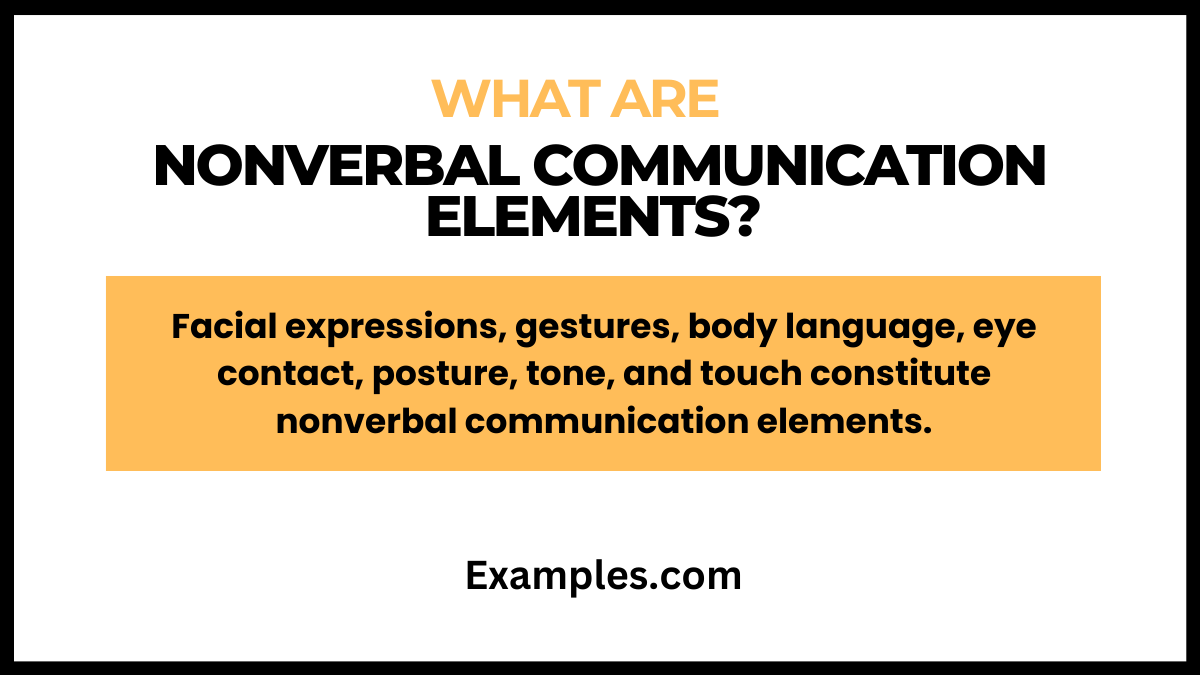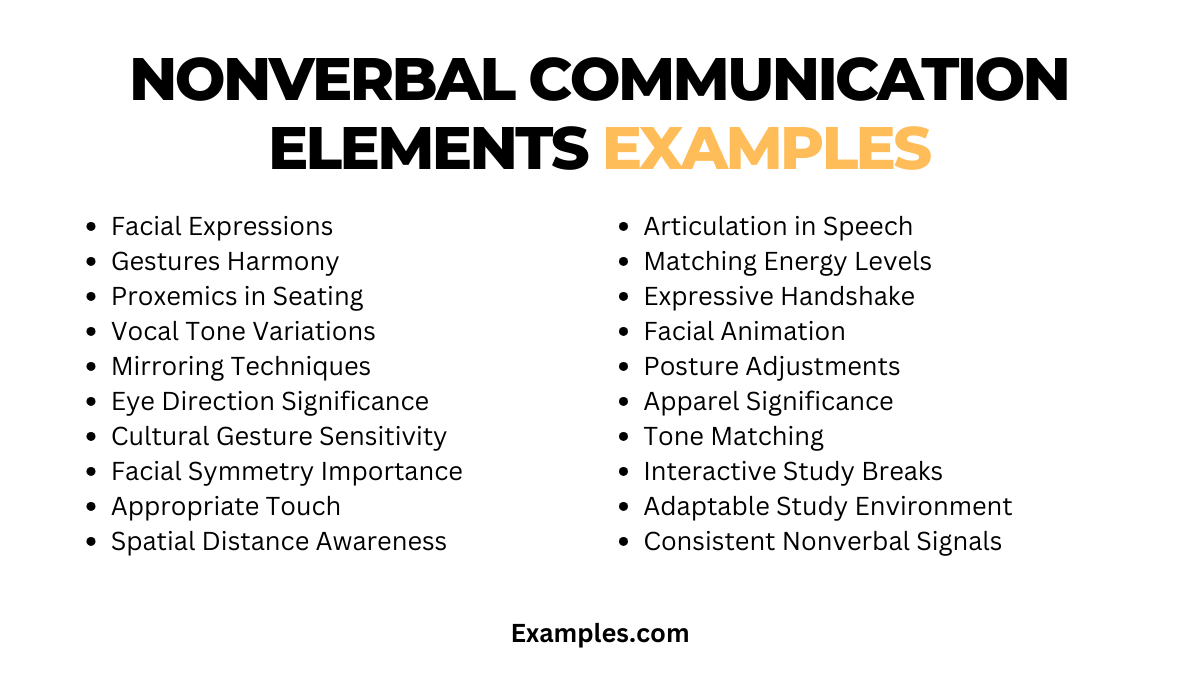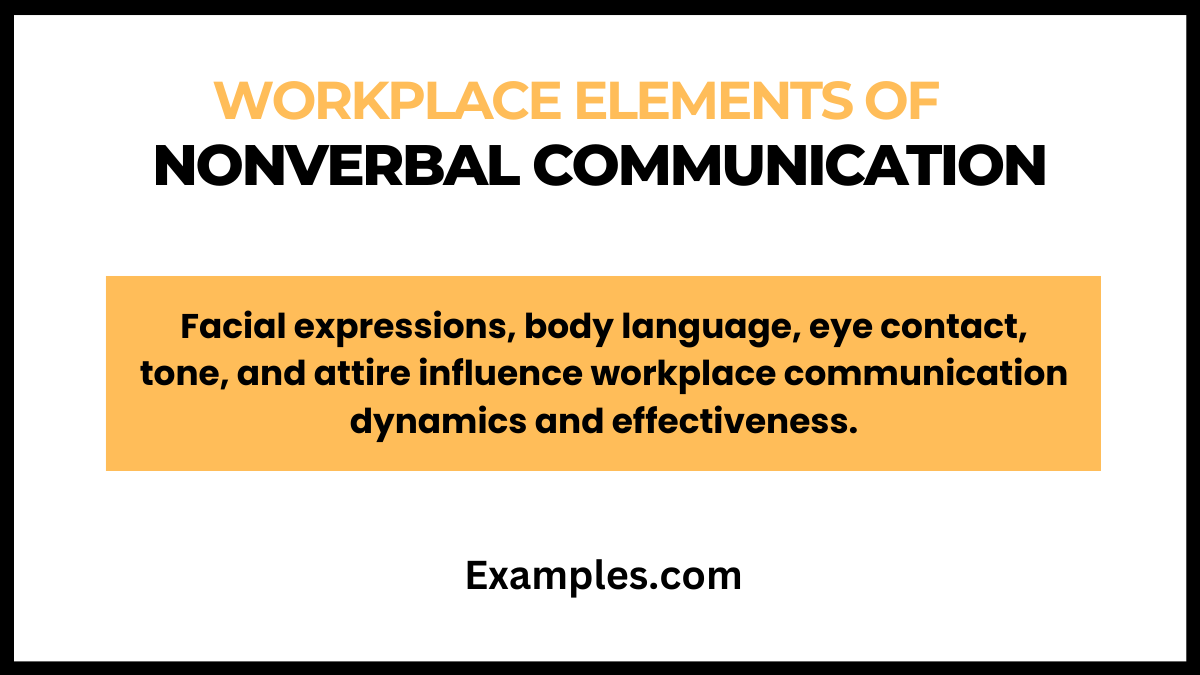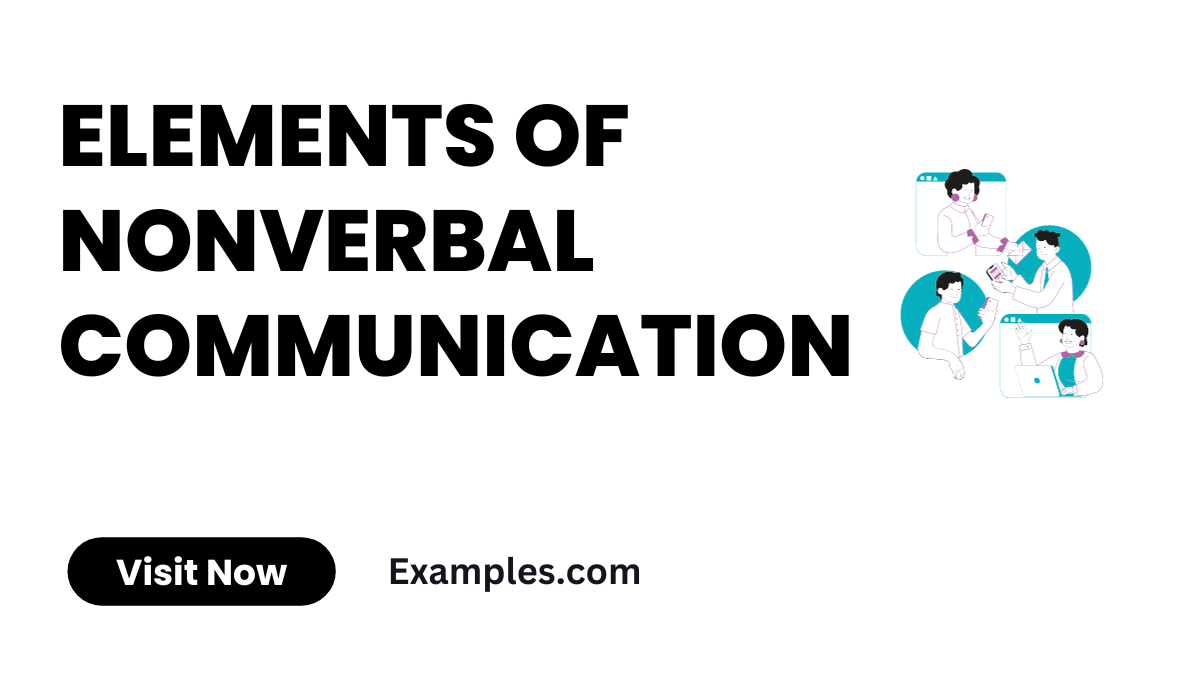29+ Elements Of Nonverbal Communication Examples
Unlock the intricate language of nonverbal cues that transcends spoken words. This comprehensive guide explores the diverse Elements of Nonverbal Communication, delving into the silent nuances that shape our interactions. From body language to facial expressions, understand how these elements play a pivotal role in conveying emotions, intentions, and messages without uttering a word.
What are Elements of Nonverbal Communication?

In straightforward terms, Elements of Nonverbal Communication encompass the unspoken aspects that accompany verbal messages. These include gestures, facial expressions, body language, and more, collectively forming a rich tapestry of cues that complement and enhance spoken communication. Recognizing and interpreting these elements contribute to a deeper understanding of interpersonal dynamics.
30 Elements of Nonverbal Communication Examples

Explore the rich tapestry of Elements Of Nonverbal Communication, each contributing uniquely to human interaction. From expressive facial cues to the dynamics of body language, these elements shape the silent language that communicates emotions, intentions, and connections. Dive into this guide for a nuanced understanding of nonverbal communication’s intricacies and its profound impact on daily interactions.
- Facial Expressions: A warm smile conveys approachability and positivity, fostering a welcoming environment in social interactions.
- Gestures Harmony: Coordinated hand gestures enhance verbal communication, providing clarity and emphasizing key points.
- Proxemics in Seating: Choosing appropriate seating distances influences comfort and engagement during various social settings.
- Vocal Tone Variations: Modulating voice tone effectively conveys emotions, adding depth and nuance to verbal communication.
- Mirroring Techniques: Mirroring gestures subtly fosters rapport, creating a sense of connection and understanding.
- Eye Direction Significance: The direction of eye gaze can indicate focus, interest, or even discomfort, enriching communication.
- Cultural Gesture Sensitivity: Being aware of culturally sensitive gestures prevents unintended misunderstandings and fosters cross-cultural harmony.
- Facial Symmetry Importance: Balanced facial expressions contribute to a genuine and trustworthy demeanor in various communication settings.
- Appropriate Touch: Using touch judiciously in communication, such as a friendly handshake, can strengthen connections.
- Spatial Distance Awareness: Understanding the appropriate spatial distance in different contexts ensures comfortable and respectful communication.
- Crisis Management with Nonverbal Signals: Effectively using calming gestures and maintaining composure in crisis situations communicates stability.
- Articulation in Speech: Clear articulation ensures that verbal communication is easily understood, minimizing chances of miscommunication.
- Matching Energy Levels: Adjusting energy levels to match the situation contributes to effective communication, promoting a harmonious exchange of ideas.
- Expressive Handshake: A firm and expressive handshake conveys confidence and professionalism in various social and business interactions.
- Dynamic Nonverbal Expression in Creative Brainstorming: Encouraging team members to use dynamic nonverbal cues during brainstorming sessions stimulates creativity and innovation.
- Facial Animation: Animated facial expressions during storytelling captivate listeners, making the narrative more engaging and memorable.
- Posture Adjustments: Adapting posture to the context, such as sitting attentively during a lecture, showcases active and respectful communication.
- Apparel Significance: Understanding the impact of clothing choices on communication helps convey professionalism and cultural awareness.
- Tone Matching: Adjusting one’s tone to match the context ensures communication resonates appropriately, promoting better understanding.
- Effective Nonverbal Signals in Networking Events: Using confident body language and maintaining a warm smile enhances networking success in professional and social events.
- Interactive Study Breaks: During study breaks, matching energy levels and using expressive hand movements in conversations enhances camaraderie among students.
- Adaptable Study Environment: Adjusting spatial distance and nonverbal cues in different study settings ensures a comfortable and focused learning atmosphere.
- Interactive Model of Communication: Engaging in interactive communication models promotes effective information exchange and shared understanding.
- Consistent Nonverbal Signals: Aligning verbal and nonverbal cues ensures coherence, minimizing the risk of misinterpretation in communication.
- Facial Relaxation: Maintaining a relaxed facial expression in casual conversations creates a comfortable and inviting atmosphere.
- Navigating Nonverbal Signals in Group Outings: Observing and interpreting nonverbal cues in group outings helps individuals navigate social dynamics and foster positive connections.
- Expressive Study Groups: In study groups, using animated facial expressions and gestures enhances communication, fostering a collaborative and dynamic learning atmosphere.
- Effective Classroom Seating: Choosing appropriate seating distances ensures a balanced spatial environment, contributing to a conducive learning atmosphere.
- Balanced Nonverbal Expression in Public Speaking: Maintaining a balanced and controlled nonverbal expression during public speaking enhances the audience’s engagement and understanding.
- Navigating Nonverbal Communication for Remote Collaboration: In virtual meetings, using clear gestures and facial expressions enhances remote collaboration, ensuring effective communication.
Elements Of Nonverbal Communication Examples Components
Unveil the intricate Components of Nonverbal Communication, where subtle cues play a significant role in human interaction. From facial expressions to gestures, explore these components to comprehend the silent language that enriches communication, fostering deeper connections and understanding.
Examples:
- Adaptive Facial Expressions: Adapting facial expressions to convey understanding or surprise enhances communication during diverse interactions.
- Strategic Gestures: Employing purposeful gestures in presentations emphasizes key points, elevating the impact of verbal messages.
- Spatial Seating Dynamics: Strategic seating arrangements influence group dynamics, affecting collaboration and communication flow.
- Dynamic Vocal Modulation: Varied vocal tones during storytelling captivate audiences, making narratives more engaging and memorable.
- Cultural Gesture Adaptation: Adjusting gestures to align with cultural norms prevents misunderstandings and fosters cross-cultural communication.
- Tactile Communication: Appropriate touch in communication, like a comforting pat on the back, communicates support and connection.
- Environmental Nonverbal Cues: Elements within an environment, such as lighting and spatial layout, contribute to nonverbal communication dynamics.
- Synchronized Team Gestures: In team settings, synchronized gestures enhance unity and cohesion, fostering effective collaboration.
- Strategic Posture Adjustments: Adapting posture to convey attentiveness or assertiveness enhances nonverbal communication in various contexts.
- Nuanced Clothing Choices: Choosing attire that aligns with the context and audience contributes to effective nonverbal communication.
Elements Of Nonverbal Communication Examples at Workplace

In the workplace, mastering Elements of Nonverbal Communication is paramount for effective collaboration and professional success. Explore how these examples manifest in various scenarios, shaping a positive and communicative organizational culture.
- Leadership Body Language: Confident body language from leaders fosters a positive work environment, inspiring confidence and motivation.
- Client Interaction Nonverbal Cues: Maintaining professionalism through appropriate gestures and facial expressions ensures successful client interactions.
- Virtual Meeting Dynamics: Adapting nonverbal cues for virtual meetings, like maintaining eye contact on camera, enhances remote collaboration.
- Boardroom Posture Elegance: Maintaining a poised posture in boardroom meetings conveys professionalism and leadership competence.
- Crisis Management Gestures: Calm and reassuring gestures during crises communicate stability and instill confidence in the workplace.
- Inclusive Team Dynamics: Encouraging diverse nonverbal expressions within teams enhances inclusivity and strengthens collaborative bonds.
- Professional Seating Etiquette: Applying strategic seating arrangements in meetings contributes to a balanced and effective communication flow.
- Feedback Session Body Language: Using open and receptive body language during feedback sessions fosters a constructive and supportive atmosphere.
- Expressive Brainstorming Gestures: Dynamic gestures during brainstorming sessions stimulate creativity, contributing to innovative solutions.
- Nonverbal Adaptation in Diverse Cultures: Being mindful of nonverbal communication variations in a diverse workplace fosters cross-cultural understanding.
Elements Of Nonverbal Communication Examples at School
In educational settings, Elements of Nonverbal Communication significantly impact student-teacher interactions and peer relationships. Explore how these examples manifest in the school environment, shaping effective communication and learning dynamics.
Examples:
- Engaging Classroom Posture: Maintaining an engaged posture during class enhances student-teacher communication, fostering a positive learning atmosphere.
- Interactive Group Project Gestures: Using coordinated gestures within student groups emphasizes unity and shared goals, contributing to project success.
- Facial Expressions in Study Groups: Expressive facial cues during study groups enhance communication, making learning sessions more dynamic and engaging.
- Respectful Nonverbal Signals in Discussions: Maintaining respectful nonverbal cues in group discussions contributes to a positive and collaborative learning environment.
- Teacher’s Dynamic Classroom Gestures: Teachers using dynamic gestures during lectures capture student attention, making lessons more memorable and impactful.
- Effective Seating Arrangements: Strategic seating choices in the classroom promote a balanced spatial environment, contributing to focused learning.
- Interactive Study Breaks: During study breaks, matching energy levels and using expressive hand movements in conversations enhance camaraderie among students.
- Positive Body Language in Exams: Teachers exhibiting positive body language during exams create a calm and focused atmosphere for students.
- Inclusive Communication Styles: Promoting inclusive communication styles, like nodding and encouraging expressions, contributes to a positive school culture.
- Adapting Nonverbal Communication in Outdoor Classes: Adjusting nonverbal cues for outdoor classes ensures effective communication, considering the unique dynamics of open learning spaces.
How Nonverbal Communication Plays an Important Role in Our Daily Life?
Nonverbal communication is a silent powerhouse shaping our daily interactions. From facial expressions to gestures, it adds depth and nuance to verbal messages, influencing relationships, perceptions, and emotional connections. In our daily lives, nonverbal cues convey sincerity, build trust, and express emotions beyond words. Whether at home, work, or social settings, understanding and harnessing the power of nonverbal communication enhances the quality of our interactions, fostering richer and more meaningful connections.
What Things Does Nonverbal Communication Depend On?
Nonverbal communication is a multi-faceted interplay influenced by various factors:
- Cultural Context: The interpretation of nonverbal cues varies across cultures, making cultural awareness crucial for effective communication.
- Individual Differences: Personal experiences, beliefs, and personality traits shape how individuals express and interpret nonverbal signals.
- Relationship Dynamics: Nonverbal communication adapts based on the nature of relationships, whether familial, professional, or social.
- Emotional State: One’s emotional state significantly influences nonverbal cues, with facial expressions and body language reflecting feelings.
- Environmental Factors: The physical environment, including lighting, seating arrangements, and spatial dynamics, impacts nonverbal communication.
- Social Norms: Adherence to societal norms dictates acceptable nonverbal behaviors, influencing communication in various social contexts.
- Contextual Relevance: Nonverbal communication’s effectiveness depends on how well it aligns with the context and purpose of the interaction.
- Communication Medium: The mode of communication, whether face-to-face, virtual, or written, influences the expression and interpretation of nonverbal cues.
- Power Dynamics: In hierarchical settings, power dynamics influence nonverbal cues, reflecting authority, submission, or collaboration.
- Adaptability: Successful nonverbal communication relies on adaptability, allowing individuals to navigate diverse situations and audiences.
What Elements of Nonverbal Communication Do You Most Frequently Notice?
- Facial Expressions: Subtle changes in expressions convey emotions and intentions.
- Gestures: Hand movements and gestures complement verbal messages, adding depth.
- Body Language: Posture, movements, and gestures collectively communicate unspoken messages.
- Eye Contact: The intensity and duration of eye contact reveal engagement, interest, or discomfort.
- Tone of Voice: Variations in vocal tone convey emotions, enthusiasm, or seriousness.
Tips for Effective Elements Of Nonverbal Communication
- Conscious Observation: Be attentive to nonverbal cues, enhancing your ability to interpret and respond.
- Adapt to Context: Adjust nonverbal expressions based on the setting and the people involved.
- Mirror Positive Behavior: Reflect positive nonverbal cues to foster connection and rapport.
- Use Consistent Signals: Align verbal and nonverbal messages to avoid confusion and enhance clarity.
- Cultural Sensitivity: Be aware of cultural nuances in nonverbal communication to avoid misinterpretation.
- Practice Active Listening: Engage in active listening, incorporating nonverbal cues to show attentiveness.
- Adaptable Posture: Adjust your posture to convey confidence, openness, or professionalism.
- Effective Use of Gestures: Employ purposeful gestures to emphasize key points and enhance communication impact.
- Maintain Facial Expressions: Express emotions appropriately through facial cues to convey sincerity.
- Balance Nonverbal Elements: Ensure a harmonious balance of nonverbal elements for nuanced and effective communication.
Nonverbal communication elements, as detailed in the guide, is a multifaceted and powerful aspect of human interaction. It transcends verbal communication, adding depth, nuance, and sincerity to our messages. For further exploration of nonverbal communication, especially in professional contexts, Harvard Business Review (https://hbr.org) offers insightful articles and studies. Their resources provide a deeper understanding of nonverbal cues in leadership and workplace dynamics. Additionally, the Psychology Today website (https://www.psychologytoday.com) is a valuable resource for understanding the psychological aspects of nonverbal communication. It offers articles and expert opinions on how nonverbal cues affect and reflect our mental states and interpersonal relationships.
In conclusion, mastering the art of nonverbal communication is crucial for enriching our interactions and fostering deeper, more meaningful connections in all areas of life. Recognizing and adapting to the complex factors that influence nonverbal cues can significantly enhance our communication skills, both personally and professionally.



